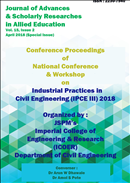RWH – A Low Cost Method for Secondary Purpose
Assessing the feasibility and benefits of rainwater harvesting in a college campus
Keywords:
RWH, secondary purpose, forest cubiertas, water and soil hold, hydrological cycle, rainwater harvesting, ground water resources, rooftop rainwater harvesting, water requirement, Indian Metrological Department, water qualityAbstract
– As forest cubiertas are decreasing. Hence water and soil hold by roots, plants are degraded. And it is affecting hydrological cycle badly. This is resulting in tremendo increase in the depth of ground water level. It is high time to implement rainwater harvesting projects. These technologies are simple and easy to install and to operate. Rainwater harvesting is artificial recharge of ground water resources and i t is commonly adopted and cost effective method of replenishing the ground water reservation. In the present study attempt has been made to examine the status of water requirement and proposed rooftop rainwater harvesting potential in the college campus. JSPM, Wagholi located in Pune district has been undertaken for the present investigation. The average rainfall in the study area is maximum 603 mm. The proposed study is based on primary and secondary data. Primary data collected from field work and secondary data collected from Indian Metrological Department (IMD, Pune). Rooftop rainwater harvesting methods and ground water recharge method are used in present study. The daily water requirement per person is 135 liters. The annual daily and dry days water requirements has been calculated in liters. Our college campus instauratur with 242811.36 m2 area of rooftop and ground surface. Population of college is about 12,000 (average) including students, teaching and non-teaching staffs. Thus the rooftop rainwater harvesting would be a solution for drinking and domestic water sustainability of the college. We check the quality of water, hardness and pH of water, DO, BOD, COD (water test) after collecting the rain water. Result obtained from the present study suggested that rainwater harvesting method is more essential in college campus.Downloads
Download data is not yet available.
Published
2018-04-27
Issue
Section
Articles
How to Cite
[1]
“RWH – A Low Cost Method for Secondary Purpose: Assessing the feasibility and benefits of rainwater harvesting in a college campus”, JASRAE, vol. 15, no. 2, pp. 159–162, Apr. 2018, Accessed: Jan. 12, 2026. [Online]. Available: https://ignited.in/index.php/jasrae/article/view/7909











